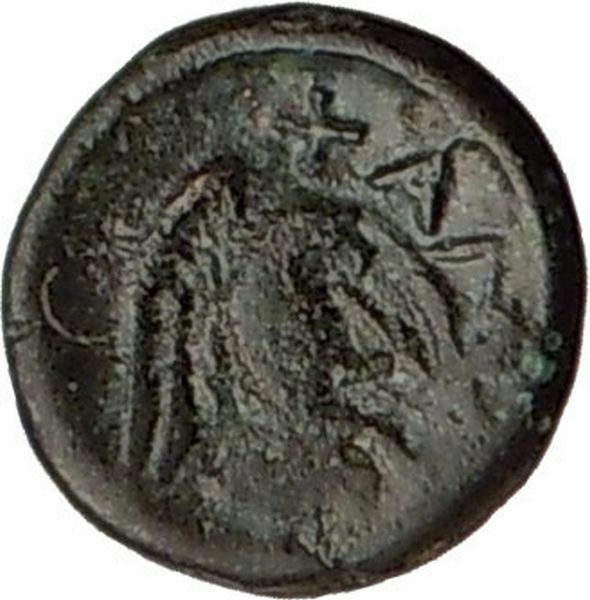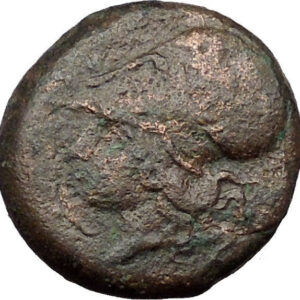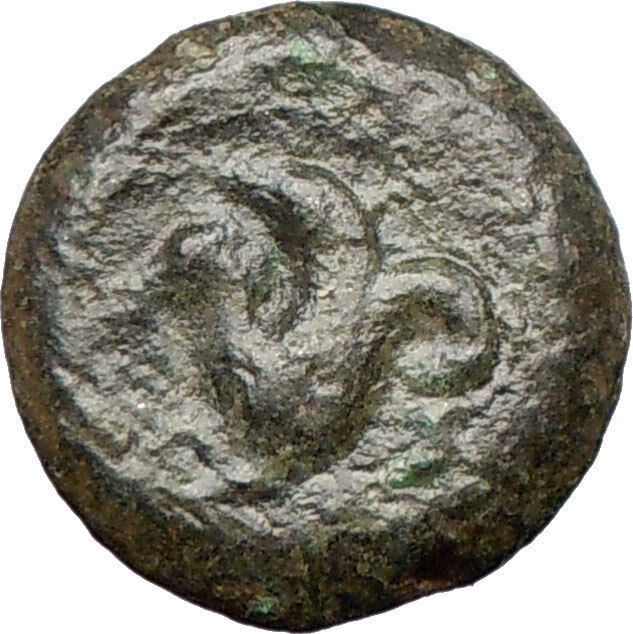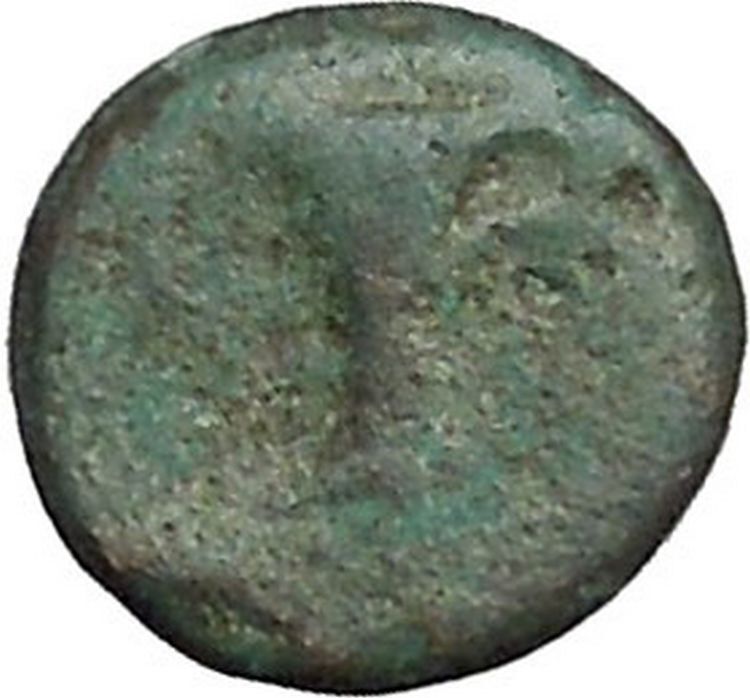|
Greek city of Magnesia ad Maeandrum in Ionia
Bronze 15mm (3.37 grams) Struck circa 300-200 B.C.
Reference: cf. SNG Copenhagen 820
Horseman galloping right, holding spear.
Bull butting left; ΜΑΓN above.
Situated south-east of Ephesus, on a tributary of the Maeander, Magnesia was originally founded from Thessaly but was re-established by colonists from Miletos in the 7th century B.C.
You are bidding on the exact item pictured, provided with a Certificate of Authenticity and Lifetime Guarantee of Authenticity.
 In Greek and Roman mythology, Apollo, is one of the most important and diverse of the Olympian deities. The ideal of the kouros (a beardless youth), Apollo has been variously recognized as a god of light and the sun; truth and prophecy; archery; medicine and healing; music, poetry, and the arts; and more. Apollo is the son of Zeus and Leto, and has a twin sister, the chaste huntress Artemis. Apollo is known in Greek-influenced Etruscan mythology as Apulu. Apollo was worshiped in both ancient Greek and Roman religion, as well as in the modern Greco-Roman Neopaganism. In Greek and Roman mythology, Apollo, is one of the most important and diverse of the Olympian deities. The ideal of the kouros (a beardless youth), Apollo has been variously recognized as a god of light and the sun; truth and prophecy; archery; medicine and healing; music, poetry, and the arts; and more. Apollo is the son of Zeus and Leto, and has a twin sister, the chaste huntress Artemis. Apollo is known in Greek-influenced Etruscan mythology as Apulu. Apollo was worshiped in both ancient Greek and Roman religion, as well as in the modern Greco-Roman Neopaganism.
As the patron of Delphi (Pythian Apollo), Apollo was an oracular god – the prophetic deity of the Delphic Oracle. Medicine and healing were associated with Apollo, whether through the god himself or mediated through his son Asclepius, yet Apollo was also seen as a god who could bring ill-health and deadly plague as well as one who had the ability to cure. Amongst the god’s custodial charges, Apollo became associated with dominion over colonists, and as the patron defender of herds and flocks. As the leader of the Muses (Apollon Musagetes) and director of their choir, Apollo functioned as the patron god of music and poetry. Hermes created the lyre for him, and the instrument became a common attribute of Apollo. Hymns sung to Apollo were called paeans.
In Hellenistic times, especially during the third century BCE, as Apollo Helios he became identified among Greeks with Helios, god of the sun, and his sister Artemis similarly equated with Selene, goddess of the moon. In Latin texts, on the other hand, Joseph Fontenrose declared himself unable to find any conflation of Apollo with Sol among the Augustan poets of the first century, not even in the conjurations of Aeneas and Latinus in Aeneid XII (161-215). Apollo and Helios/Sol remained separate beings in literary and mythological texts until the third century CE.
Magnesia or Magnesia on the Maeander (Ancient Greek: Μαγνησία ἡ πρὸς Μαιάνδρῳ or Μαγνησία ἡ ἐπὶ Μαιάνδρῳ; Latin: Magnesia ad Maeandrum) was an ancient Greek city in Ionia, considerable in size, at an important location commercially and strategically in the triangle of Priene, Ephesus and Tralles. The city was named Magnesia, after the Magnetes from Thessaly who settled the area along with some Cretans. It was later called “on the Meander” to distinguish it from the nearby Lydian city Magnesia ad Sipylum.
The territory around Magnesia was extremely fertile, and produced excellent wine, figs, and cucumbers. It was built on the slope of Mount Thorax, on the banks of the small river Lethacus, a tributary of the Maeander river upstream from Ephesus. It was 15 miles from the city of Miletus. The ruins of the city are located west of the modern village Tekin in the Germencik district of Aydın Province, Turkey.
Magnesia lay within Ionia, but because it had been settled by Aeolians from Greece, was not accepted into the Ionian League. Magnesia may have been ruled for a time by the Lydians, and was for some time under the control of the Persians, and subject to Cimmerian raids. In later years, Magnesia supported the Romans in the Second Mithridatic War.
General history
Magnesia soon attained great power and prosperity, so as to be able to cope even with a challenge from Ephesus. However, the city was taken and destroyed by the Cimmerians, some time between 726 BC and 660 BC. The deserted site was soon reoccupied, and rebuilt by the Milesians or, according to Athenaeus, by the Ephesians. The Persian satraps of Lydia also occasionally resided in the place.
In the fifth century BC, the exiled Athenian Themistocles came to Persia to offer his services to Artaxerxes, and was given control of Magnesia to support his family.
The name “magnet” may come from lodestones found in Magnesia.
In the time of the Romans, Magnesia was added to the kingdom of Pergamus, after Antiochus had been driven eastward beyond Mount Taunts. After this time the town seems to have declined and is rarely mentioned, though it is still noticed by Pliny and Tacitus. Hierocles ranks it among the bishoprics of Asia, and later documents seem to imply that at one time it bore the name of Maeandropolis. The existence of the town in the time of the emperors Aurelius and Gallienus is attested to by coins.
Landmarks
Magnesia contained a temple of Dindymene, the mother of the gods; the wife or daughter of Themistocles, was said to have been a priestess of that divinity.
Strabo later noted the temple no longer existed, the town having been transferred to another place. The change in the site of the town alluded to by Strabo, is not noticed by other contemporary authors, however some suggest that Magnesia was moved from the banks of the Meander to a place at the foot of Mount Thorax three miles from the river.
The new town which Strabo saw was remarkable for its temple of Artemis Leucophryeno, which in size and the number of its treasures was surpassed by the temple of Ephesus, but in beauty and the harmony of its parts was superior to all the temples in Asia Minor. The temple to Artemis is said by Vitruvius to have been built by the architect Hermogenes, in the Ionic style.
Little remains of either temple today. The site of Magnesia on the Maeander was once identified with the modern Guzel-kissar; since then the ruins of a temple to Artemis were found at Inck-bazar, and the latter is considered a more likely site.
Modern excavations
The first excavations at the archaeological site were performed during 1891 and 1893 by a German archaeological team conducted by Carl Humann, discoverer of the Pergamon Altar. These lasted 21 months and partially revealed the theatre, the Artemis temple, the agora, the Zeus temple and the prytaneion. Excavations were resumed at the site, after an interval of almost 100 years, in 1984, by Orhan Bingöl of the University of Ankara and the Turkish Ministry of Culture.
Findings from the site are now displayed in Istanbul and Aydın, as well as in Berlin and Paris. Copies of the portico (pronaos) of the Zeus temple and of a bay of the Artemis temple can be visited in the Pergamonmuseum in Berlin. The most of the architectural remains of Magnesia have been destroyed by local lime burners. The well preserved remains of the Zeus temple have been destroyed by local residents even after Humann’s excavation campaign.
Notable people
- Bathycles (6th century BC) Greek sculptor
- Themistocles of Athens spent his final years and was buried here
|





 In Greek and Roman mythology, Apollo, is one of the most important and diverse of the Olympian deities. The ideal of the kouros (a beardless youth), Apollo has been variously recognized as a god of light and the sun; truth and prophecy; archery; medicine and healing; music, poetry, and the arts; and more. Apollo is the son of Zeus and Leto, and has a twin sister, the chaste huntress Artemis. Apollo is known in Greek-influenced Etruscan mythology as Apulu. Apollo was worshiped in both ancient Greek and Roman religion, as well as in the modern Greco-Roman Neopaganism.
In Greek and Roman mythology, Apollo, is one of the most important and diverse of the Olympian deities. The ideal of the kouros (a beardless youth), Apollo has been variously recognized as a god of light and the sun; truth and prophecy; archery; medicine and healing; music, poetry, and the arts; and more. Apollo is the son of Zeus and Leto, and has a twin sister, the chaste huntress Artemis. Apollo is known in Greek-influenced Etruscan mythology as Apulu. Apollo was worshiped in both ancient Greek and Roman religion, as well as in the modern Greco-Roman Neopaganism.




